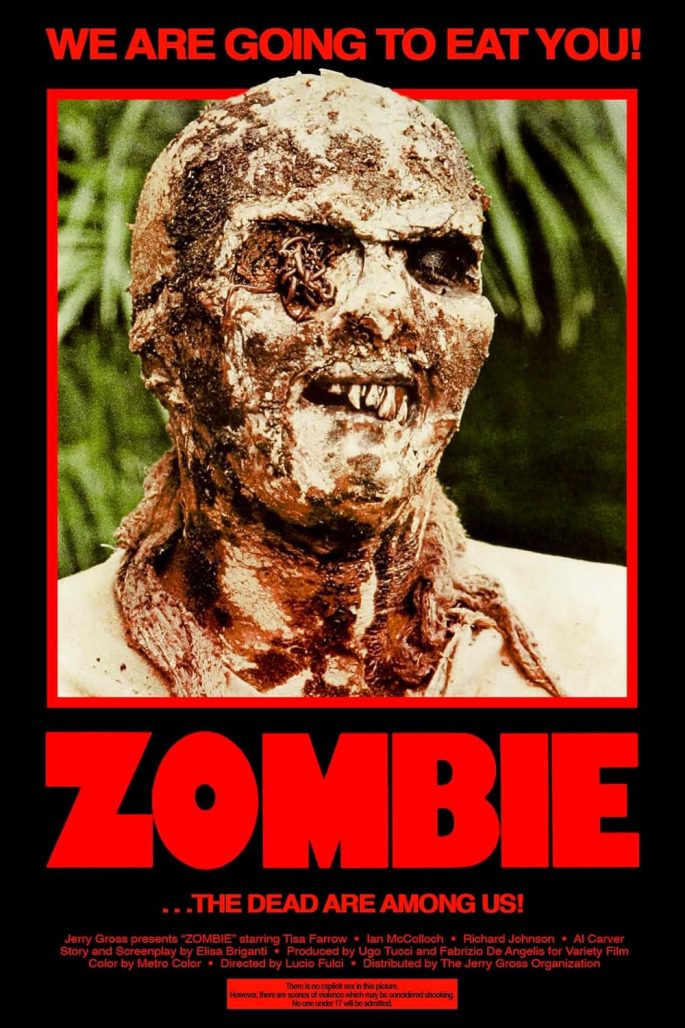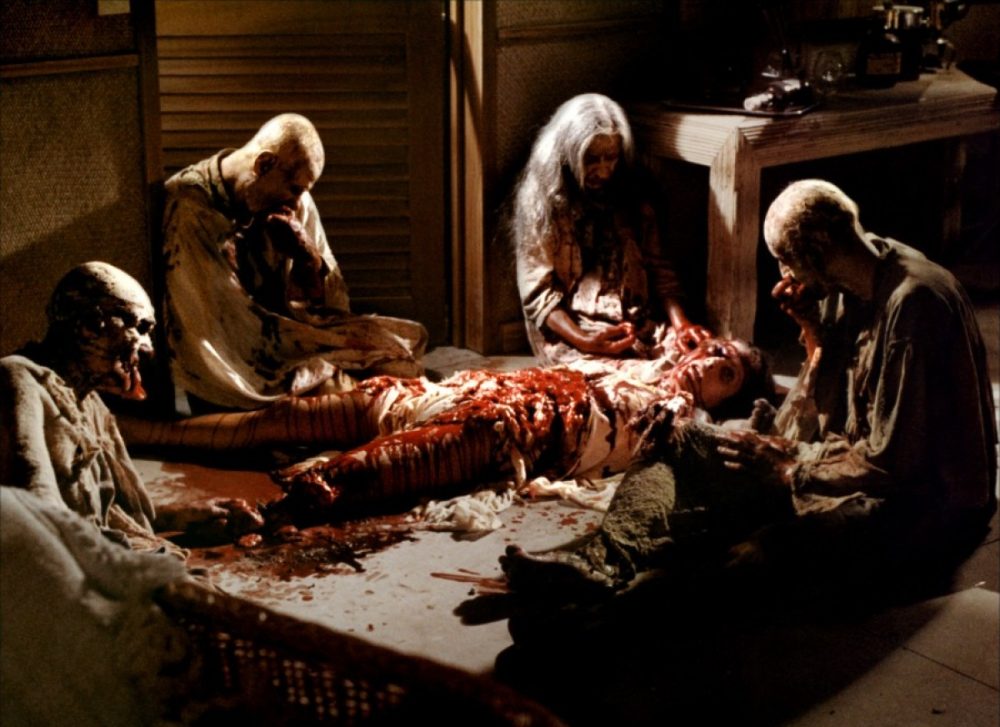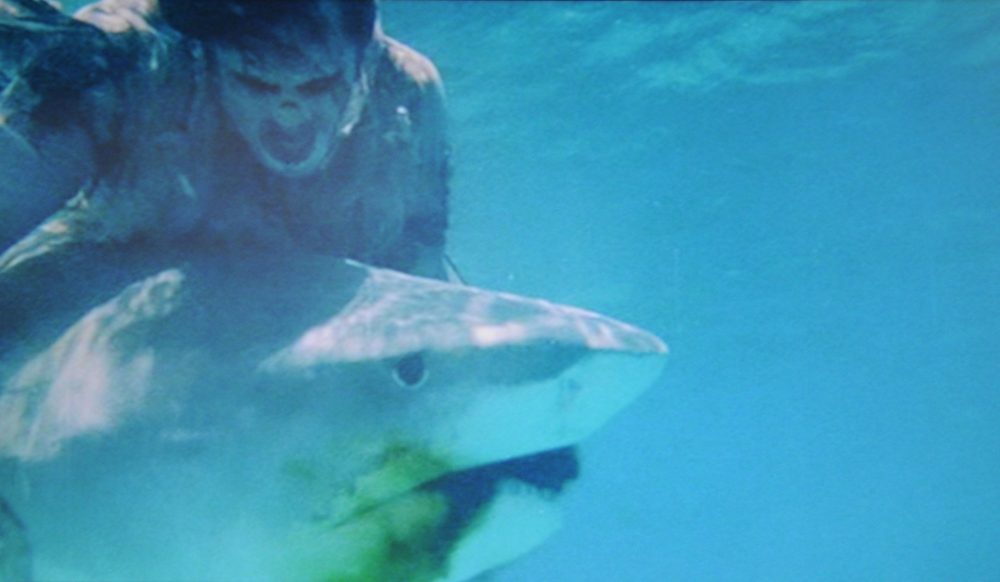Getting into zombie horror is a two-step process. The first step belongs to George Romero’s Dead Trilogy (Night, Day, and Dawn) given the fact it established and then built upon the modern zombie. Simply put, they’re the gold standard. From Night of the Living Dead (1968) onward, reanimated corpses owe a debt to the master of horror that brought them to the big screen. Anyone asks where to start, you point them to Romero.
The second step, by no means less important or less impactful, belongs to Lucio Fulci’s Zombi 2 (1979), a movie that injected sol much brutality and gratuitousness into the genre that it changed the very nature of zombie violence. Fulci is Italy’s own master of horror and herald of gore, a man that challenged the status quo to venture deeper into the macabre. He’s as inevitable as Romero. Journeying into living dead cinema means crossing paths with one of the most bloodthirstily creative minds to ever have put flesh eaters on film.

There’s no better way to celebrate Fulci’s 98th birthday (he passed in March 13, 1996 at 68 years of age) than by watching the movie that put Italian zombie horror on the map: Zombi 2. Also known as Zombie Flesh Eaters, the movie was released as a sequel to Romero’s Dawn of the Dead in Italy, which premiered in the US a year earlier. Director Dario Argento had reedited Dawn and released it as Zombi there, which is why there’s a ‘2’ in Fulci’s movie (and if you’re ever bothered by an obnoxious know-it-all horror fan at a party that’s got this nugget of trivia at the ready, now you can beat them to the punch).
Zombi 2 starts in New York Harbor. Two patrolmen board an abandoned boat only to find a zombie that kills one of them. In comes Anne Bowles (Tisa Farrow), the daughter of the man whose boat belongs to. She quickly links up with a journalist called Peter West (Ian McCulloch), who is investigating the story of the boat and the rumors surrounding it. Bowles’s father suffering from a strange disease gets to Anne and Peter, prompting them to set out to the Caribbean island of Matool. They hire transport and two guides, Brian and Susan, to go and find answers. What they find are undead islanders, failed science, and gallons of blood. Oh, and a zombie that’s not against the idea of fighting a shark.
Fulci wasn’t one to go for social criticism or political messaging like Romero did in his zombie movies. Rather, his vision for the undead is more nightmarish. The metaphors operating behind the scenes in the Dead Trilogy make its zombies somewhat tragic, as if they were empty humans reduced to cannibalistic hunger. This doesn’t make them less scary or threatening, just more complex. Zombi 2’s flesh eaters look like creatures that climbed up straight from Hell to torment the living. There’s no tragedy here. There’s only the guarantee of a very painful and gruesome death. What’s a social crisis for Romero is a nihilistic nightmare for Fulci.

The scene that best captures this vision belongs to the classic eye-gouging kill. There are two researchers who are investigating the strange phenomenon of corpse reanimation on site at Matool. One of them, a woman called Paola, retires for the evening. Shortly after, already at her house, a zombie tries to get through her front door. In the struggle, the zombie punches a hole through it, leaving sharp splinters around the new opening. The zombie grabs Paula by the hair and slowly pulls her to the blade-like splinters. The audience gets an extreme closeup of her eye getting gouged out as it meets the wood. The shot lingers a bit, indulging in the gore surrounding the wound. The rest is horror history.
Zombies are known as ravenous flesh eaters. Consuming human meat is what fuels these shambling bags of decomposing skin, limbs, and organs. Fulci’s zombies, though, go for the thrill of the kill first. It’s like they enjoy being sadistic, finding purpose in the act of tearing people apart first and feasting on them second. This adds to the nightmare logic as their unpredictability imbues them with a sense of irrational violence that injects intentional malice to their behavior. To a point, it’s as if they weren’t entirely brainless. As if they give some thought to the manner in which they want their victims to die.
Rounding out Fulci’s undead nightmare vision is the zombie vs. shark sequence. As the team approaches Matool, one of the guides, Susan, decides to explore the waters. Shortly after diving in, she crosses paths with a shark. While hiding from it, she’s surprised by a zombie that’s been lying in wait near a reef. As Susan tries to escape, the shark joins in the struggle, resulting in a fight between one of the ocean’s most fearsome killers and a reanimated corpse. At one point, the zombie attempts to sink its teeth into the shark.

Again, a dream-like scenario plucked from the darkest recesses of horror imagination. An underwater nightmare that cancels out any hope that there’s a safe place left anywhere on the planet once the dead came back to life. It helps that the scene is beautifully shot, capturing the vibrant colors of the sea and juxtaposing them with the rot zombies carry on their bodies both literally and figuratively. It’s a violation of nature. Unnatural death knows no bounds.
There are a few other elements present throughout that further ground Fulci’s zombies in his nightmare world. Some of the undead rise from the grounds of an old Conquistador graveyard tucked away on the island of Matool, with one being the author of a particularly gruesome neck bite. The final set piece takes place in a hospital that’s slowly being invaded by zombies both from the outside and from within, the latter a result of infected patients succumbing to their ailments and then reanimating. It’s as close to Hell as zombies have gotten to in film, and it stands as one of the most terrifying encounters in horror cinema.
It takes a lot of intestinal fortitude to engage with Fulci. The movies he followed up with after Zombi 2 attest to this. He would go on to start his Gates of Hell Trilogy in 1980 with City of the Living Dead (also known by the more apt title The Gates of Hell), with The Beyond and House by the Cemetery completing it 1981. Each film pushed the boundaries of violence to create even more sinister nightmares for fans to voyage into. And yet, Zombi 2 feels like the foundation, the source of all evil. It’s the reason why the zombie genre would feel incomplete had Lucio Fulci not lent his talents to this expression of horror. His birthday isn’t just one of the best reminders of this, but also a great excuse to watch or rewatch his movies.

